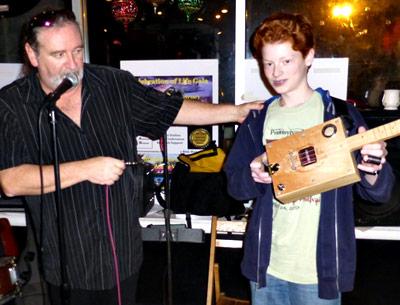A ‘True Musical Soul’ Makes Cigar-Box Guitars at 13

It seems perfectly appropriate that a meeting at the crossroads — in this case, Crossroads Music on Amagansett Square — should spark a local musical phenomenon.
There was no selling of souls at this crossroads. But just as Robert Johnson, through his haunting, primitive recordings like “Cross Road Blues” and “Hellhound on My Trail” ultimately gave rise to rock ’n’ roll, the convergence of Michael Clark, Crossroads Music’s owner; Kerry Kearney, a professional guitarist and 2013 inductee to the New York Blues Hall of Fame, and Casey Baron, a 13-year-old boy from New Hyde Park, has local musicians buzzing about a new line of instruments on the scene.
Upon seeing and hearing Casey’s cigar-box guitars, of which he has made nearly 60, Mr. Clark signed on to become the instruments’ exclusive dealer. On the same day, Mr. Kearney invited the young luthier to perform with him at an upcoming show, which took place early this month. And at least one local musician has purchased and incorporated a Casey Baron cigar-box guitar into his performances.
Cigar-box guitars are not new: appearing sometime in the 19th century, they are among the homemade, do-it-yourself instruments, like the washtub bass, that have powered folk and blues soloists and ensembles for generations. The wooden cigar box serves as the resonator, such as the body of a standard acoustic guitar. The instrument’s neck is a broomstick or wooden slat, and strings — often three or four — are stretched from one end of it to the opposite end of the cigar box.
Unlike the cigar-box guitar’s earlier days, when impoverished musicians built their own instruments out of necessity, technology aided in the development of Casey’s hobby, one he may turn into a business.
“I guess it started when I was about 10,” Casey said last week. “I was getting into stand-up bass, and eventually stumbled across a video online of someone who made a 2-string stand-up bass out of a cardboard box.” Further research led him to the website cigarboxnation.com, where complete how-to instructions for building a cigar-box guitar are freely available.
His first guitar, Casey said, turned out “okay, I guess.” On subsequent efforts, “I’d do that instead of this. Learn as you go, to improve.” He quickly added electric models to the inventory by sourcing the required additional parts. “I went to Radio Shack and got a piezo transducer contact mike,” he said. “The problem is, they feed back. But after doing more research, I started adding, sometimes, magnetic pickups to electrify them.”
Casey has used standard electric guitar pickups in his creations, but now favors those made by boutique manufacturers in Austria and California, both of which he discovered online. Construction, which happens in a workshop in his basement, generally takes a couple of weeks, “depending on if I have the parts. The great thing is, if it doesn’t come out how you like it, you can always noodle around.”
Last summer, Casey’s aunt dropped by Crossroads Music while on the South Fork to visit relatives in East Hampton. “My sister said to Mike, ‘I’m sure you hear this all the time, but I have two nephews that are quite talented. One builds his own cigar-box guitars,’ ” Casey’s mother, Lois Baron, said.
“I get this a lot, to be honest,” Mr. Clark confirmed. “I wasn’t expecting too much, because she told me he was 13. But when he brought them in, I could see that they were done with quality.”
As it happened, Casey had brought several of his instruments to show Mr. Clark on the day of Mr. Kearney’s workshop, one of several held at the store this fall. “I didn’t even know that he could play,” Mr. Clark said. “Once he started playing, I said, ‘You need to come back later and talk to Kerry, show him these guitars.’ ”
At Mr. Kearney’s workshop, Mr. Clark said, Casey “sat down literally for 30 seconds and played, and Kerry said, ‘What are you doing next Thursday? I want you to open for me, and bring one of those guitars with you.’ Kerry did not hesitate for a second. He was just blown away by it. Everybody just loves the ‘coolness’ factor.”
“ ‘This kid’s got to come jam with us. This is great!’ ” is how Mr. Kearney remembered his meeting with Casey. “We have a big show coming up in January called the Gathering of the Slides that we’ll be playing in Patchogue, and I would love for him to be on the show with us. It’s a true inspiration to see someone so young have such a deep-rooted love for the blues. He has a true musical soul.”
“It’s so refreshing to see something like that happen,” Mr. Clark said of Casey’s meeting with Mr. Kearney. “This kid is so into it! Who knows what will happen in the future, but just to know that he met [Kerry] here is so cool.”
Randolph Hudson, a guitarist who plays with local bands including Black and Sparrow, the Complete Unknowns, and Joe Delia and Thieves, was an early adopter, buying one of Casey’s 3-string electric models, which he uses with Black and Sparrow. “People flip over it, they love the sound,” he said. “I love that it’s three strings and limited in what you can do, but within that limitation there’s so much you can do. I am interested in talking to him next time he’s around — I might commission him to make another for me.”
Casey, a soft-spoken teenager, is taking all the attention in stride. He performed with Mr. Kearney on Nov. 2 at Crazy Beans, a coffee house and eatery in Miller Place, and seemed pleased but almost bemused by the local reaction to his instruments.
What do his peers think of his nascent avocation, he was asked. “They think it’s pretty cool,” he said.
